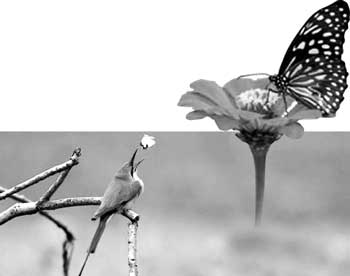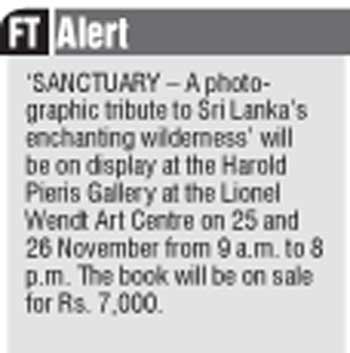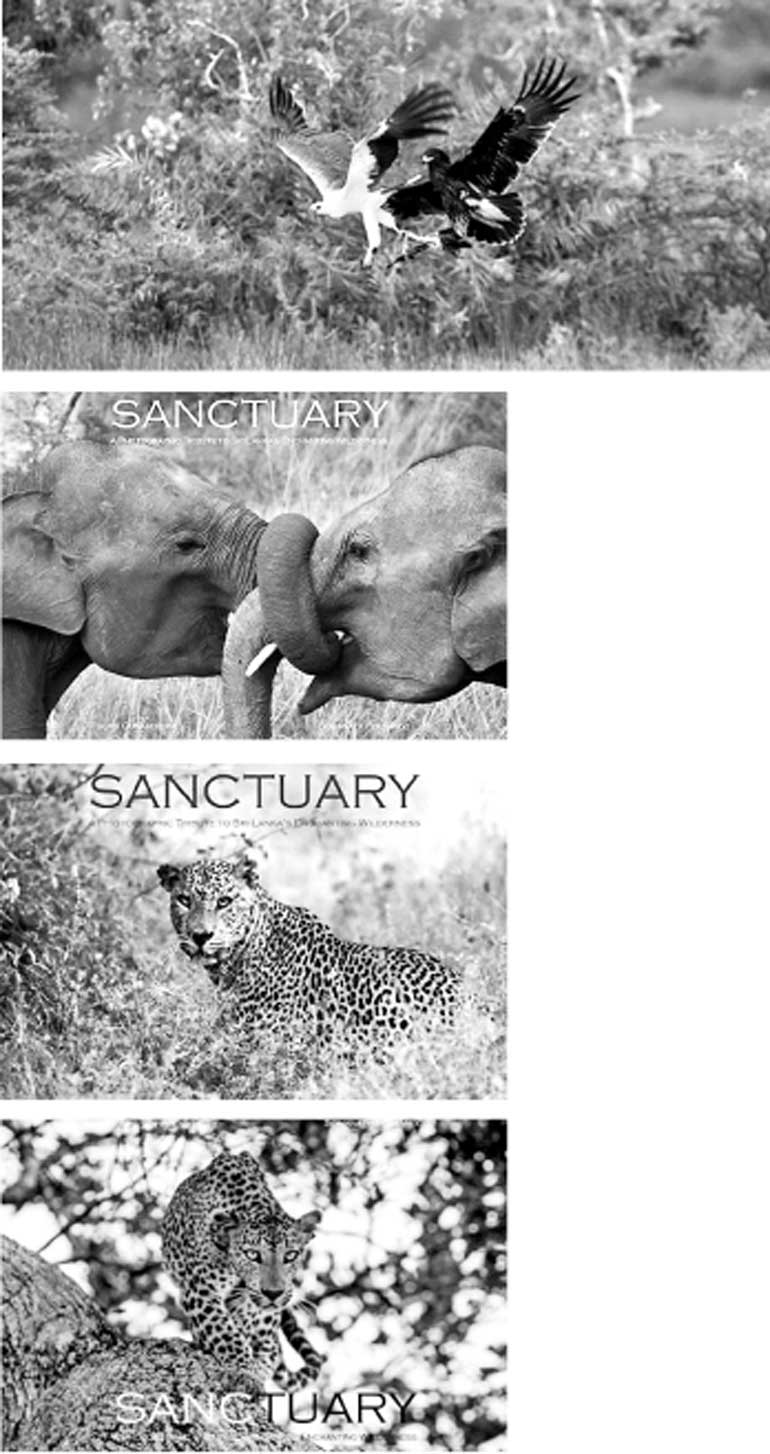Sunday Dec 14, 2025
Sunday Dec 14, 2025
Saturday, 18 November 2017 00:59 - - {{hitsCtrl.values.hits}}
 The quality of Sri Lanka’s wildlife with its almost unparalleled biodiversity is not news to anybody, at least not anymore. There was a time, before the end of the war, that all of the country’s hidden wonders were known to just a select few enthusiasts. This small band has now grown considerably, but that, as they say, is the price of progress. Whether that is how it should be, though, is a different matter.
The quality of Sri Lanka’s wildlife with its almost unparalleled biodiversity is not news to anybody, at least not anymore. There was a time, before the end of the war, that all of the country’s hidden wonders were known to just a select few enthusiasts. This small band has now grown considerably, but that, as they say, is the price of progress. Whether that is how it should be, though, is a different matter.
Recently there were loud protestations from the public as well as environmental groups over the decision to allow 500 jeeps to enter Yala National Park each day. That number had been reduced to 200 a day in October so as to prevent overcrowding, but following opposition from the safari jeep drivers associations’ the decision was overturned.
While this issue will undoubtedly rage on, in the meantime it might be best for the stakeholders involved in taking such decisions to take a step back and possibly observe more keenly what exactly is at stake.
Making this task considerably easier are photographers Isuru Gunasekera and Somanath Fernando. They have this month released ‘SANCTUARY,’ their photographic tribute to Sri Lankan wildlife. A 280-page book, comprising 250 images and a further 30 features, it is a must-own for anyone with even a passing interest in knowing Sri Lanka as she truly is.
The content has been gathered by the two over the course of eight years, traversing all of Sri Lanka’s glorious parks and reserves, with just one end goal in mind: raising awareness.
“The main theme of this book is to highlight the importance of the legally unprotected and unguarded patches of land, forests and jungles of Sri Lanka. We make the point in the book that over half our images have been captured in these vulnerable wild retreats,” says Fernando.
“If we don’t extend the same levels of protection to these unguarded areas, images as seen in this book will not be possible in the future. This is why we decided to call this book ‘SANCTUARY’ to establish the importance of both the protected and vulnerable Sanctuaries of Sri Lanka.”
The duo also hope that the book, while highlighting the need for conservation, will offer a timely reminder as to what exactly it is that needs conserving; it is easy to take the natural gifts this country has for granted, but preserving those gifts is where the challenge lays.
Fernando spoke to Daily FT regarding the book and the journey compiling it, as well as his hopes and concerns regarding the state of Sri Lanka’s wildlife. Following are excerpts:
By Madushka Balasuriya
Q: It’s clear that protecting Sri Lanka’s wildlife is the overarching goal with the release of this book. As such would you be able to possibly elaborate on some changes (for better or worse) you have seen?
A: Overall, we would say that our attempts at protecting the environment, even those that we are lawfully compelled to protect, are woefully inadequate. Take for example the loss of habitat around the Wilpattu national park, which has been in the news lately. Having said that, the initiative by the government and forestry department to increase the forest cover of the country is a step in the right direction and so is the new rule being put in place to limit the number of vehicles in the Yala National Park [note: the interview was conducted prior to the Government overturning this decision].
Q: Where could we be doing more in terms of conservation?
A: Limiting the number of visitors to parks, is definitely a must. Whilst there is opposition from small business owners on this front, we must find a way to work with them, finding the possibly alternate sources of complementary income associated with the parks so that it is a common goal and not a divided one. Protecting the periphery of the Wilpattu National Park from the current deforestation is critical. Whilst it may be outside the legal boundaries of the park, clearing these buffer zones have a massive impact on the park itself.
Q: When did you and Isuru come up with the concept?
A: We have been wildlife enthusiasts practically all our lives, and photographers for the last 10 years or so. Being photographers also made us view wildlife in an entirely different perspective. In order to capture the images we envisaged, we had to watch our subjects very carefully, understand their behaviour, predict what they might do next and generally understand their routines at a deeper level. As a result of a many hours on the field we were fortunate to capture many images which we felt were special enough to share with likeminded individuals. This book has been working in progress for many years now, and we are delighted to finally bring it out.
Q: How long have you harboured an interest in wildlife?
A: Well, practically our whole lives. It’s true that once the wildlife bug bites you, there’s no turning back. For us it just kept evolving, going from nature and wildlife enthusiasts to photographers over the years.
Q: What sets Sri Lanka’s wildlife apart?
A: Sri Lanka is unique in many ways. Along with the Western Ghats, Sri Lanka is considered a biodiversity hotspot on the back of the range and variety of endemic species in both flora and fauna. And nowhere in the world can you find the large land mammals like the elephant, bear and leopard just a few miles away from the largest sea mammal the blue whale. The number of endemic species is also incredible for a country with such a small land area.
Q: What can people expect to see in the book?
A: The book consists of 280 pages including 250 high quality images and 30 articles of personal experiences attached to some selected photographs. There have been many books before us from some amazing and talented photographers, most of who are our friends. We wish to continue in spreading the same message as they have done in an effort to keep shedding more light to the importance of conservation. We must all play our part.
The book focuses on both the protected and unguarded wild retreats of the country and establishes the importance of both these areas as over half our images were captured in these vulnerable places, so we hope that viewers and readers of our book realise the importance of conservation and preservation and become advocates of this very challenging journey.
 Q: In your adventures, which parks and reserves have you found the most interesting?
Q: In your adventures, which parks and reserves have you found the most interesting?
A: It’s difficult to pick one that is most interesting, as they are all unique in their own way and offers a different type of experience. Having said that, we must admit that our favourite patch of the wild is the Sinharaja Rainforest. There is quite nothing like it for us in terms of the variety of birds, the closeness to natures, the sounds of the forest and the smells of the earth. It’s also brings in us a sense of peace which is different from the others.
Q: You mentioned that the pictures in the book will be accompanied by anecdotes. Are there any that didn’t make the final cut, if so, would you be willing to share one or two?
A: Whilst all 250 images in the book have interesting stories behind them, we had to choose only about 30 write to about, else we’ll have to publish quite a few! Many stories of playing the waiting game, often hidden and in uncomfortable situations, and also quite often leaving empty handed. Whilst there were anguished missed opportunities and failed attempts, never was there moments of regret or disappointment. The journey and experience regardless of the success of the shot was reward enough.
